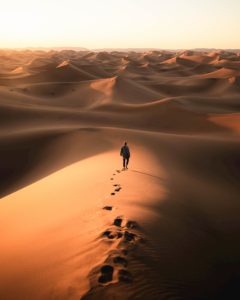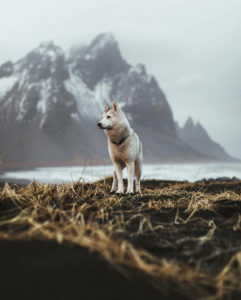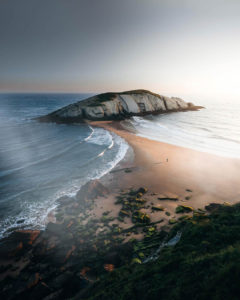
Kay Van Huisseling
Media creative
@justkay
“I want to share images that makes people stop for a second and think: “Wow, our earth is epic.” That feeling I want to convey.”
Kristoffer Vangen is a professional photographer based in Troms, Norway. He started just about three years ago, when he was on a trip to Japan. He was amazed by the diversity of the country, the newness of everything compared to what he had seen in other countries. Back then he was just photographing this unique experience with his phone, using the little knowledge he had about photography. As soon as he got home he bought a camera and developed his photography skills. He has been inspired by Steffen Fossbakk, Fan Ho and Konsta Punkka, among others.
Kris sees photography as art, and at the same time as a documentation of a specific place – including its elements and conditions – at a specific moment, that will never look the same again in the future. Since he is living in Norway, he has had quite some chances to document the northern lights in both photo and video. He shared with us some tips about capturing the lights successfully: “The lights have its own forecast; there are several apps and websites to check this. The two factors you should specifically check are the ‘KP index’ and the ‘speed’”.
Capturing the northern lights in a certain way he had in mind might not be that easy, but that is directly what he enjoys about photography: the hard work he has to put in to get the results he is looking for. About one of his photos he says: “Hiking in pouring rain, creating the frame, taking lots of pictures and going through them all to find the right one is part of what makes this photo my favorite.”
Curious about what more Kris told us in the interview? Keep reading!
Welcome Kristoffer!
To start with, we would like to know where you started… Where and how did photography step into your life? And how is it part of your daily life now?
Photography was something that had interested me for a while already before I decided to buy a camera. Looking back, it was actually a trip that tipped me over the edge. I went to Japan about three years ago, and everything was so different from what I was used to. I just wanted to photograph everything, and I tried my best doing that with a phone and the little knowledge I had.
One of my friends I was travelling with works as a journalist, and therefore knows a lot about photography. He told me that I did a lot of things right in terms of composition. So I thought, maybe I can learn this quickly, with some hard work.
How would you define photography, from your point of view and experience? And what makes that definition the right one for you?
I think I would define it as freezing a moment, a moment that might be special to you, or others. Photography is used in many ways, some may define it as documentation, others may say it’s art.
In my type of photography, landscape and nature in general, I would say it’s both. On the one hand, I look at it as art: The way you work with the camera and lenses and how you edit a picture to make it look as intended. On the other hand, you are always documenting a place with certain elements and weather conditions, capturing what it looked like the moment you were there – knowing it will never look exactly the same. That’s the documenting part.
You are based in Norway, a place where many photographers wish to go to. Norway has incredible landscapes all over the country, but many people have a goal… Seeing the northern lights, and capturing them. You have taken many incredible shots and time lapses from the northern lights yourself. What are the secrets? How and where can you capture these lights most successfully?
Yes, we are lucky to have the possibility to see the northern lights so often!
There are some things to keep in mind when you want to see the lights. First of all, the further north you go, the bigger the chances are. If you visit the southern part of Norway for example, the chances are very small. Norway is a long country, with one part above the polar circle.
Other than that, it’s a lot the same as for other types of outdoor photography. Check the forecast; you need clear skies. The lights also have its own forecast; there are several apps and websites to check this. The two factors you should specifically check are the ‘KP index’ and the ‘speed’.
The ‘sad’ thing about night photography is that it’s pretty gear dependant. If you want a high quality picture, you sometimes need expensive gear to gather the most light and keep the noise level down. Also a sturdy tripod is a must.
How would you describe yourself as photographer and how do you make sure you distinguish yourself?
I’m not sure if I manage to distinguish myself, but I do try! I think I’m somewhere in between the traditional landscape style, and the newer ‘Instagram style’ of taking photos. My style right now is not dependant on one type of color or subject. In addition, the seasons are so vastly different where I live that it would be hard take the effects out.
I have certain tones I prefer to use or highlight in my pictures though. Also I try to make my pictures very clean and simple; they tend to come out way more simplified compared to what you would experience being at the spot in person. And that’s the point, I try to show one thing at a time, but still with some elements to create depth. It’s a combination of careful composition choices, type of conditions and editing.
Can you tell us about your editing style and explain your editing process? What steps do you take and what software do you use?
I use both Lightroom and Photoshop, I would say around 80% Lightroom. I edit very differently from picture to picture, some are just slightly edited, but others take more work to get the look I want.
I don’t use a lot of presets, but I have made some for general use. My experience is that I have to do the same amount of editing after applying the preset anyway. Usually what takes the most time for me is balancing the colors. That has to be right for me, not too much and not too little.
As a photographer, I am sure that you feel attached to all your photos. All your pictures represent unique moments of your life. However, among your works, do you have any picture that you really like? What is your favorite photo?
I have a picture of one of the local mountains here, called Segla. The angle is pretty common, but I created a frame out of a branch and some leaves to create some extra interest and depth. The sky was covered by clouds and I took the photo in between some serious rain showers.
Hiking in pouring rain, creating the frame, taking lots of pictures and going through them all to find the right one. Also, I got a lot of nice feedback from people on this shot, which is always appreciated! It was as well one of the pictures that really got my Instagram account going forward.
So far, what has photography taught you about yourself and the world?
What is your approach when it comes to planning your trip and finding your ideal locations?
This is one of my weak sides, I’m not very good at planning, I just want to go! But I use Instagram a lot, saving pictures from locations and talking to people through messages. Everything is online now, there is always a blogger or photographer who has visited a place and has written about it.
Is there any artist/photographer who has inspired your art? Can you name three?
I think my inspiration goes all over the place, but there are some I could mention:
Steffen Fossbakk, he’s one of the local photographers that taught me a lot in the beginning and really got me started. Also a great guy, and photographer of course.
Fan Ho, because I feel like mentioning at least one artist from back in the day. His work is so timeless; it’s incredible to me how he made those pictures with the equipment available back then.
Konsta Punkka, his photos are always interesting to me and I feel they are ‘untouched’ by all the trends going around.
Nowadays we see so many young talented artists pursuing a career as a full time travel/landscape photographer. What four pieces of advice would you give them?
I don’t work as a full time photographer myself, so I’m probably not the right person to ask. But one thing I think is very important to keep in mind these days, is that most people can’t just be a photographer anymore. If you start professionally, there is a lot of work outside the photography part, depending on what genre you are pursuing. There has always been in some aspects, but now you have to constantly keep up with social media, promoting yourself and maybe even promoting yourself as a brand. It’s not just your pictures you have to work on.
There is a lot of good photographers out there who never get noticed by brands, customers or other people. The marked is pretty saturated. It’s definitely doable, but I think you have to push it, and think outside just the pictures!
Probably you have lots of places on your wishlist to visit and photograph! Any new projects coming up or countries you will be visiting soon?
There is always places I want to go, and I constantly think about where I should go next! Nothing is written in stone yet, but for 2020, I think I will visit Finland in January, Chile and Bolivia in March and Japan sometime during the fall. It all depends on whether I’ll manage to plan it out, haha.

“I want to share images that makes people stop for a second and think: “Wow, our earth is epic.” That feeling I want to convey.”

“Nowadays photography is the perfect excuse to travel and explore the world. When photography is involved, everything is more exciting. I really like to combine tattooing and photography while I travel.”

Frederik Schindler Videographer, photographer, and traveler based in Germany “Can there be a better treat than traveling with the people
